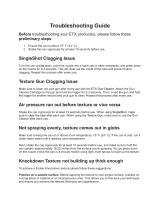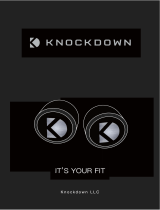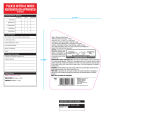
Property of Homax Products, Inc.
FAQs
Product: Homax Knockdown Aerosol Texture
(THD SKU 140875/Homax Item #4065-06)
Why do I have to shake the can?
You should shake the can hard a full minute before using and then stop to shake briefly every 15
seconds or so. The first shake is intended to move settled material off the bottom of the can and
break it up. Not shaking adequately may result in a clogged nozzle, poor spray pattern, or
excessively runny texture.
Shaking periodically during spraying helps recharge the pressure in the can and will help
maintain the spray pressure throughout the life of the can. Not spraying periodically during
spraying will result in weak spray delivery as the can is depleted.
Can I use this on the ceiling?
While the texture material is suitable for ceiling surfaces the spray nozzle is not configured for
spraying on ceiling surfaces. As the can is tipped to spray vertically, the pick-up tube inside the
can will eventually not be immersed in the texture liquid at the bottom of the can and it will only
spray gas. This will result in the propellant being depleted with texture remaining in the can.
Why does it spray with a slow or weak spray delivery?
Generally an aerosol knockdown texture will have a weaker spray than most other aerosols. This
is because it is designed not to atomize the contents, but rather spray a large splatter of material
on the surface. High pressure sprays break up the texture splatter too much. As long as the
texture will reach the wall surface with the desired splatter size, then it is spraying well.
There may be several other reasons for very weak or dribbling spray from the tip of the nozzle.
Most commonly, a weak spray (sprays only a few inches from the nozzle) is a result of the can
being sprayed at too cool of temperature. If the can itself is below 68 degrees, you may get a
poor spray delivery. If it is below 65 degrees, it will not likely spray well or at all, and you may
not get all the material out of the can. By simply warming up the can (This can be done by
running warm tap water over the can or placing it in a warm location for a period of time), it will
spray with a higher pressure spray.
Another reason for weak spray is failure to shake the can well prior to spraying or failure to
shake the can periodically while spraying. Shaking the can helps allow the propellant to build
pressure in the can as it is sprayed – this “recharges” the pressure in the can. As a rule of thumb,
for every 15 seconds of spraying time stop and shake the can about 10 shakes.

Property of Homax Products, Inc.
Why am I not getting the coverage I expect?
One reason is that heavier texture applications or coarser textures will get lower coverage. If you
are applying very heavy textures or multiple spray coats you can expect lower coverage than
finer textures. In addition, when applying texture be sure to cover only approximately 80% of
the surface. Applying more than 80% of the surface will result in less overall coverage and a
less than desirable match.
Also, if you are spraying and hearing gas come from the can but no texture there is a problem
with the texture liquid reaching the pickup tube in the bottom of the can. Be sure to hold the can
vertically so the pickup tube is reaching into the liquid texture in the bottom of the can. If you
evacuate gas without texture material the can may lose its ability to spray leaving unspent
material in the can.
Why is the texture runny?
The texture may appear light in color or runny when wet but may be perfectly fine. Be sure to
apply a spray pattern that enables you to match your texture. It is recommended you practice on
a piece of drywall or cardboard. If it sags slightly on a vertical wall that should not be an issue
once it is “knocked down” with a knife.
Also be sure to shake the can well so all the texture material is thoroughly mixed. Failure to
shake the can well may leave solid material in the bottom of the can that will cause excessively
runny texture.
The initial material sprayed also is also excessively runny and should be “cleared” from the can
and disposed prior to spraying on a wall.
Why am I not getting a knockdown texture?
The process for creating a knockdown is to spray a splatter texture over 50-80% of the wall,
allow it to firm up for 1-2 minutes, and then using a drywall knife, flatten the tops of the
splatters, which is termed “knocking down “ the texture.
If you press too hard on the knife you will flatten the texture splatters completely. You want
little to no pressure on the knife blade when dragging it across the splatters. The goal is to flatten
just the tops of the round texture lobes. Also hold the knife blade almost parallel to the wall
surface as you lightly drag the blade edge across the texture. (Look for demonstration videos
online.)
I am getting “lines” on my texture, what can I do to avoid that?
If the surface of your texture has lines in it – these may be “drag marks” left behind from the
knife dragging across the surface. You can avoid these by keeping your drywall knife edge clean
(remove any particles that may cause drag marks), also wetting the knife blade periodically
helps, and most importantly - allowing slightly less wait time after spraying and then knocking it
down. (If you are waiting 2 minutes after spraying, try waiting 1-1/2 minutes or 1 minute after
spraying to knock down). It may be easier to work in smaller sections of a wall area at a time to
allow less time after spraying to get all the texture uniformly knocked down.

Property of Homax Products, Inc.
When I move the drywall knife over the texture to “knock it down”, the texture flattens out
– what am I doing wrong?
It’s likely too much pressure is being applied with the knife. You want to hold the knife parallel
to the wall with 2 fingers (thumb and forefinger) and just let it glide gently over the surface with
virtually no pressure applied. The intent is to flatten the just tops of the liquid splatters on the
surface but not flatten them completely out.
Secondly, you might also try allowing the texture to wait another minute longer before knocking
down, this will firm it up. Generally, 1-2 minutes after spraying is the ideal time to wait before
knocking it down with a knife. In humid environments, this may take slightly longer.
Why is the can spraying less distance as I continue to spray?
(See slow or weak spray above.)
Do I need to prime over the texture spray?
Yes, it is recommended. The primer will help seal the surface of the texture splatters helping
ensure a uniform painted / gloss appearance.
The can stopped spraying but still is partially full – what happened?
Likely it ran out of pressure. Test for this by squeezing the can sides firmly – if the can is able to
be squeezed in slightly then likely pressure is depleted. If the can had been spraying gas but no
liquid prior to stopping, the propellant may be been depleted. To avoid this, shake the can hard a
full minute before starting to spray, then stop spraying every 15 seconds, shake it 10 times, and
resume spraying. Also be sure the can is held in a vertical position – this will ensure the pick-up
tube inside the can reaches the lowest point in the can so it can pull up liquid texture material to
the nozzle.
In rare instances when there is both pressure and material in left in the can and it stops spraying,
a clog may have occurred in the valve or pick up tube. This may be due to insufficient shaking
which left particles in the can that clog the valve. First, clear the nozzle with water to make sure
dried texture is not blocking the nozzle. Second, allow the can to sit for approximately 20
minutes. Last, re-shake the can hard and try re-spraying.
Why is the spray too fine?
This will be due to the nozzle being adjusted too fine, the nozzle being partially blocked by dried
texture, or the can being at too warm of temperature. Be sure to change the nozzle setting to
coarse for a larger splatter size. Clean out the nozzle by running under warm water. For less
pressure and a heavier texture, run the can under cool water to lower the can temperature to 68-
70 degrees. Even if the temperature of the can is just a few degrees above 70, it will
dramatically increase the force of spray and make the splatter finer. Therefore, adjusting
temperature down will make the splatter larger.
-
 1
1
-
 2
2
-
 3
3
Ask a question and I''ll find the answer in the document
Finding information in a document is now easier with AI
Related papers
Other documents
-
 ExperTexture 3013 User guide
ExperTexture 3013 User guide
-
 KNOCK DOWN KD1 3D Printed Custum Earbuds Owner's manual
KNOCK DOWN KD1 3D Printed Custum Earbuds Owner's manual
-
ProForm JT0370 User guide
-
ProForm 50002475 User manual
-
Graco Inc. 2030 User manual
-
Zinsser 202154 User guide
-
Marshalltown HG692 User manual
-
 Magic 3057 User manual
Magic 3057 User manual
-
Titan PowrTex™ 600DD Owner's manual
-
Graco 17H575 Owner's manual















